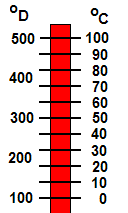ANSWERS
Here is how it is done... Let's draw a little diagram to compare the temperature scales...
We can put in the boiling and melting points and the midway temperatures of 50 oC and 300 oD So the first question can be answered by inspection...
We can calculate that each change in temperature of 1 oC is equivalent to a change in temperature on the Dalek scale of 4 oD
20 oC is therefore 20 x 4 = 80 degrees D higher than the temperature of melting ice in degrees D ( = 100oD) so it is 100 + 80 = 180oD
-100 oC is therefore 400 degrees D lower than the temperature of melting icein degrees D ( = 100oD) so it is 100 - 400 = -300oD
37oC is therefore 37 x 4 = 148 degrees D higher than the temperature of melting ice in degrees D ( = 100oD) so it is 100 + 148= 148oD
and 1000oC is therefore 1000 x 4 = 4000 degrees D higher than the temperature of melting ice in degrees D ( = 100oD) so it is 100 + 4000 = 4100oD LOJ January 2003 |
Follow me...
|






